The original tutorial series, produced by Tom Dykstra and Rick Anderson ( @RickAndMSFT ) was written using the C# language. My versions keep as close to the originals as possible, changing only the coding language. The narrative text is largely unchanged from the original and is used with permission from Microsoft.
This tutorial series teaches you how to create ASP.NET MVC 5 applications using the Entity Framework 6 and Visual Studio 2013 Express for Web. This series uses the Code First workflow. For information about how to choose between Code First, Database First, and Model First, see Entity Framework Development Workflows.
The tutorial series comprises 12 sections in total. They are intended to be followed sequentially as each section builds on the knowledge imparted in the previous sections. Progress through the sections is reflected in a Visual Studio Express for Web project download that accompanies each section which features the web application that you build through the series.
Download the code
The code for this section is available here. Save the .zip file to a convenient location and then extract the contents. Make sure you have an edition of Visual Studio 2013 installed (Express for Web, Professional, Premium or Ultimate) and double click the .sln file. Once the project is opened in your IDE, press Shift+Ctrl+B to build the solution. This will ensure that all packages are restored from Nuget and may take a while depending on your Internet connection speed.
The navigation path through the series is as follows:
- Creating an Entity Framework Data Model
- Implementing Basic CRUD Functionality
- Sorting, Filtering and Paging
- Connection Resiliency and Command Interception
- Code First Migrations and Deployment
- Creating a More Complex Data Model
- Reading Related Data
- Updating Related Data
- Async and Stored Procedures
- Handling Concurrency
- Implementing-Inheritance
- Advanced Entity Framework Scenarios
Concurrency Conflicts
A concurrency conflict occurs when one user displays an entity's data in order to edit it, and then another user updates the same entity's data before the first user's change is written to the database. If you don't enable the detection of such conflicts, whoever updates the database last overwrites the other user's changes. In many applications, this risk is acceptable: if there are few users, or few updates, or if isn't really critical if some changes are overwritten, the cost of programming for concurrency might outweigh the benefit. In that case, you don't have to configure the application to handle concurrency conflicts.
Pessimistic Concurrency (Locking)
If your application does need to prevent accidental data loss in concurrency scenarios, one way to do that is to use database locks. This is called pessimistic concurrency. For example, before you read a row from a database, you request a lock for read-only or for update access. If you lock a row for update access, no other users are allowed to lock the row either for read-only or update access, because they would get a copy of data that's in the process of being changed. If you lock a row for read-only access, others can also lock it for read-only access but not for update.
Managing locks has disadvantages. It can be complex to program. It requires significant database management resources, and it can cause performance problems as the number of users of an application increases. For these reasons, not all database management systems support pessimistic concurrency. The Entity Framework provides no built-in support for it, and this tutorial doesn't show you how to implement it.
Optimistic Concurrency
The alternative to pessimistic concurrency is optimistic concurrency. Optimistic concurrency means allowing concurrency conflicts to happen, and then reacting appropriately if they do. For example, John runs the Departments Edit page, changes the Budget amount for the English department from £350,000.00 to £0.00.

Before John clicks Save, Jane runs the same page and changes the Start Date field from 2007-09-01 to 2014-06-07.
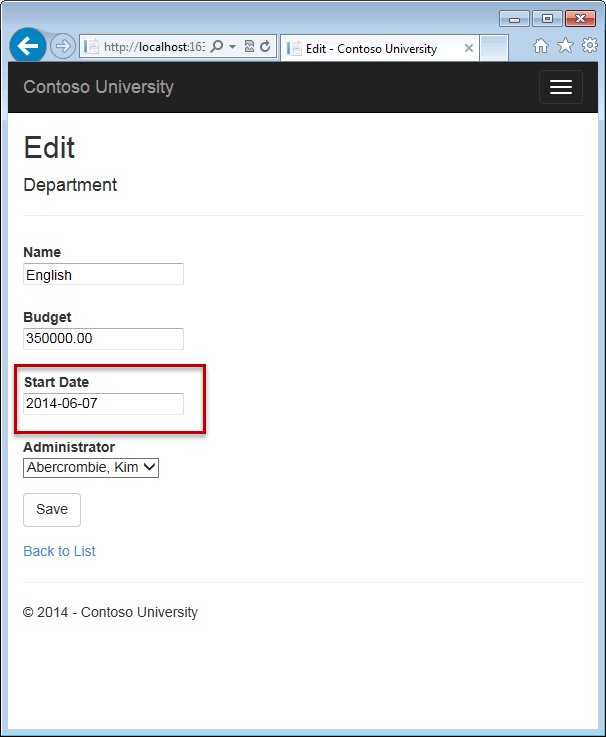
John clicks Save first and sees his change when the browser returns to the Index page, then Jane clicks Save. What happens next is determined by how you handle concurrency conflicts. Some of the options include the following:
-
You can keep track of which property a user has modified and update only the corresponding columns in the database. In the example scenario, no data would be lost, because different properties were updated by the two users. The next time someone browses the English department, they'll see both John's and Jane's changes — a start date of 2014-06-07 and a budget of £0.00.
This method of updating can reduce the number of conflicts that could result in data loss, but it can't avoid data loss if competing changes are made to the same property of an entity. Whether the Entity Framework works this way depends on how you implement your update code. It's often not practical in a web application, because it can require that you maintain large amounts of state in order to keep track of all original property values for an entity as well as new values. Maintaining large amounts of state can affect application performance because it either requires server resources or must be included in the web page itself (for example, in hidden fields) or in a cookie.
-
You can let Jane's change overwrite John's change. The next time someone browses the English department, they'll see 2014-06-07 and the restored £350,000.00 value. This is called a Client Wins or Last in Wins scenario. (All values from the client take precedence over what's in the data store.) As noted in the introduction to this section, if you don't do any coding for concurrency handling, this will happen automatically.
-
You can prevent Jane's change from being updated in the database. Typically, you would display an error message, show her the current state of the data, and allow her to reapply her changes if she still wants to make them. This is called a Store Wins scenario. (The data-store values take precedence over the values submitted by the client.) You'll implement the Store Wins scenario in this tutorial. This method ensures that no changes are overwritten without a user being alerted to what's happening.
Detecting Concurrency Conflicts
You can resolve conflicts by handling OptimisticConcurrencyException exceptions that the Entity Framework throws. In order to know when to throw these exceptions, the Entity Framework must be able to detect conflicts. Therefore, you must configure the database and the data model appropriately. Some options for enabling conflict detection include the following:
-
In the database table, include a tracking column that can be used to determine when a row has been changed. You can then configure the Entity Framework to include that column in the Where clause of SQLUpdate or Delete commands.
The data type of the tracking column is typically rowversion. The rowversion value is a sequential number that's incremented each time the row is updated. In an Update or Delete command, the Where clause includes the original value of the tracking column (the original row version) . If the row being updated has been changed by another user, the value in the rowversion column is different than the original value, so the Update or Delete statement can't find the row to update because of the Where clause. When the Entity Framework finds that no rows have been updated by the Update or Delete command (that is, when the number of affected rows is zero), it interprets that as a concurrency conflict.
-
Configure the Entity Framework to include the original values of every column in the table in the Where clause of Update and Delete commands.
As in the first option, if anything in the row has changed since the row was first read, the Where clause won't return a row to update, which the Entity Framework interprets as a concurrency conflict. For database tables that have many columns, this approach can result in very large Where clauses, and can require that you maintain large amounts of state. As noted earlier, maintaining large amounts of state can affect application performance. Therefore this approach is generally not recommended, and it isn't the method used in this tutorial.
If you do want to implement this approach to concurrency, you have to mark all non-primary-key properties in the entity you want to track concurrency for by adding the ConcurrencyCheck attribute to them. That change enables the Entity Framework to include all columns in the SQL Where clause of Update statements.
In the remainder of this tutorial you'll add a rowversion tracking property to the Department entity, create a controller and views, and test to verify that everything works correctly.
Add an Optimistic Concurrency Property to the Department Entity
In Models\Department.vb, add a tracking property named RowVersion:
Imports System.ComponentModel.DataAnnotations Imports System.ComponentModel.DataAnnotations.Schema Namespace Models Public Class Department Public Property DepartmentID As Integer <StringLength(50, MinimumLength:=3)> Public Property Name As String <DataType(DataType.Currency)> <Column(TypeName:="money")> Public Property Budget As Decimal <DataType(DataType.Date)> <DisplayFormat(DataFormatString:="{0:yyyy-MM-dd}", ApplyFormatInEditMode:=True)> <Display(Name:="Start Date")> Public Property StartDate As DateTime Public Property InstructorID As Integer? <Timestamp> Public Property RowVersion As Byte() Public Overridable Property Administrator As Instructor Public Overridable Property Courses As ICollection(Of Course) End Class End Namespace
The Timestamp attribute specifies that this column will be included in the Where clause of Update and Delete commands sent to the database. The attribute is called Timestamp because previous versions of SQL Server used a SQL timestamp data type before the SQL rowversion replaced it. The .Net type for rowversion is a byte array.
If you prefer to use the fluent API, you can use the IsConcurrencyToken method to specify the tracking property, as shown in the following example:
Protected Overrides Sub OnModelCreating(ByVal modelBuilder As DbModelBuilder) modelBuilder.Conventions.Remove(Of PluralizingTableNameConvention)() modelBuilder.Entity(Of Course)() _ .HasMany(Function(c) c.Instructors).WithMany(Function(i) i.Courses) _ .Map(Function(t) t.MapLeftKey("CourseID") _ .MapRightKey("InstructorID") _ .ToTable("CourseInstructor")) modelBuilder.Entity(Of Department)().MapToStoredProcedures() modelBuilder.Entity(Of Department)() _ .Property(Function(p) p.RowVersion).IsConcurrencyToken() End Sub
By adding a property you changed the database model, so you need to do another migration. In the Package Manager Console (PMC), enter the following commands:
Add-Migration RowVersion Update-Database
Modify the Department Controller
In Controllers\DepartmentController.vb, add an Imports statement:
Imports System.Data.Entity.Infrastructure
In the DepartmentController.vb file, change all four occurrences of "LastName" to "FullName" so that the department administrator drop-down lists will contain the full name of the instructor rather than just the last name.
ViewBag.InstructorID = New SelectList(db.Instructors, "ID", "FullName", department.InstructorID)
Replace the existing code for the HttpPost Edit method with the following code:
<HttpPost()> <ValidateAntiForgeryToken()> Async Function Edit(<Bind(Include:="DepartmentID,Name,Budget,StartDate,RowVersion,InstructorID")> ByVal department As Department) As Task(Of ActionResult) Try If ModelState.IsValid Then db.Entry(department).State = EntityState.Modified Await db.SaveChangesAsync() Return RedirectToAction("Index") End If Catch ex As DbUpdateConcurrencyException Dim entry = ex.Entries.Single() Dim clientValues = DirectCast(entry.Entity, Department) Dim databaseEntry = entry.GetDatabaseValues() If databaseEntry Is Nothing Then ModelState.AddModelError(String.Empty, "Unable to save changes. The department was deleted by another user.") Else Dim databaseValues = DirectCast(databaseEntry.ToObject(), Department) If databaseValues.Name <> clientValues.Name Then ModelState.AddModelError("Name", "Current value: " & databaseValues.Name) End If If databaseValues.Budget <> clientValues.Budget Then ModelState.AddModelError("Budget", "Current value: " & String.Format("{0:c}", databaseValues.Budget)) End If If databaseValues.StartDate <> clientValues.StartDate Then ModelState.AddModelError("StartDate", "Current value: " & String.Format("{0:d}", databaseValues.StartDate)) End If If databaseValues.InstructorID <> clientValues.InstructorID Then ModelState.AddModelError("InstructorID", "Current value: " & db.Instructors.Find(databaseValues.InstructorID).FullName) End If ModelState.AddModelError(String.Empty, "The record you attempted to edit was " & _ "modified by another user after you got the original value. " & _ "The edit operation was cancelled and the current values in the database " & _ "have been displayed. If you still want to edit this record, click " & _ "the Save button again. Otherwise click the Back to List hyperlink.") department.RowVersion = databaseValues.RowVersion End If Catch dex As RetryLimitExceededException 'Log the error ModelState.AddModelError(String.Empty, "Unable to save changes. Try again, and if the problem persists contact your system administrator.") End Try ViewBag.InstructorID = New SelectList(db.Instructors, "ID", "FullName", department.InstructorID) Return View(department) End Function
The view will store the original RowVersion value in a hidden field. When the model binder creates the department instance, that object will have the original RowVersion property value and the new values for the other properties, as entered by the user on the Edit page. Then when the Entity Framework creates a SQL UPDATE command, that command will include a WHERE clause that looks for a row that has the original RowVersion value.
If no rows are affected by the UPDATE command (no rows have the original RowVersion value), the Entity Framework throws a DbUpdateConcurrencyException exception, and the code in the catch block gets the affected Department entity from the exception object.
Dim entry = ex.Entries.Single()
This object has the new values entered by the user in its Entity property, and you can get the values read from the database by calling the GetDatabaseValues method.
Dim clientValues = DirectCast(entry.Entity, Department) Dim databaseEntry = entry.GetDatabaseValues()
The GetDatabaseValues method returns Nothing if someone has deleted the row from the database; otherwise, you have to cast the object returned to the Department class in order to access the Department properties.
If databaseEntry Is Nothing Then ModelState.AddModelError(String.Empty, "Unable to save changes. The department was deleted by another user.")
A longer error message explains what happened and what to do about it:
ModelState.AddModelError(String.Empty, "The record you attempted to edit was " & _ "modified by another user after you got the original value. " & _ "The edit operation was cancelled and the current values in the database " & _ "have been displayed. If you still want to edit this record, click " & _ "the Save button again. Otherwise click the Back to List hyperlink.")
Finally, the code sets the RowVersion value of the Department object to the new value retrieved from the database. This new RowVersion value will be stored in the hidden field when the Edit page is redisplayed, and the next time the user clicks Save, only concurrency errors that happen since the redisplay of the Edit page will be caught.
In Views\Department\Edit.vbhtml, add a hidden field to save the RowVersion property value, immediately following the hidden field for the DepartmentID property:
@Using (Html.BeginForm()) @Html.AntiForgeryToken() @<div class="form-horizontal"> <h4>Department</h4> <hr /> @Html.ValidationSummary(true) @Html.HiddenFor(Function(model) model.DepartmentID) @Html.HiddenFor(Function(model) model.RowVersion)
Testing Optimistic Concurrency Handling
Run the site and click Departments:
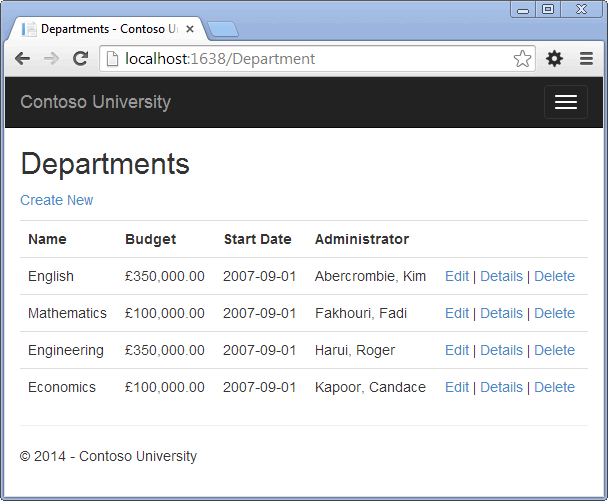
Right click the Edit hyperlink for the English department and select Open in new tab, then click the Edit hyperlink for the English department. The two tabs display the same information.
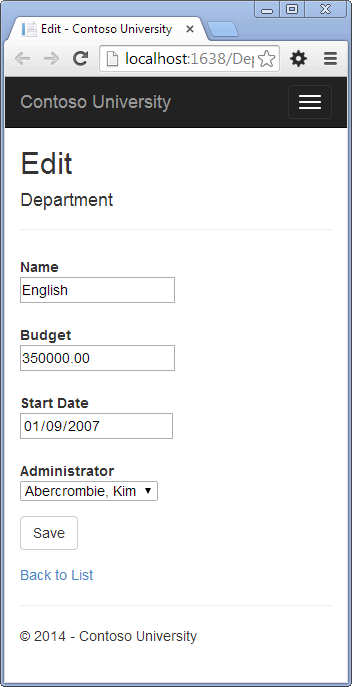
Change a field in the first browser tab and click Save.
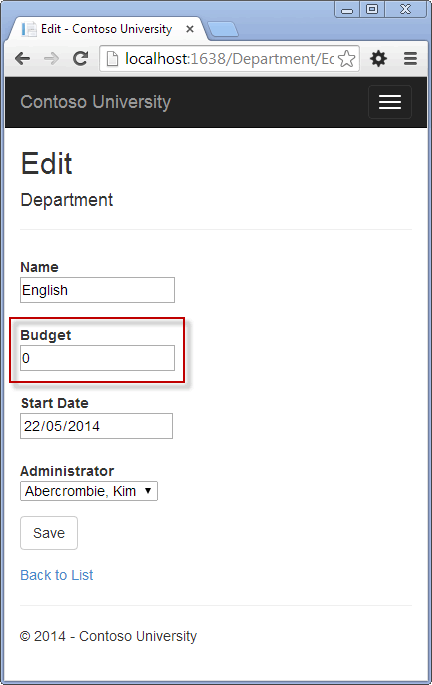
The browser shows the Index page with the changed value.
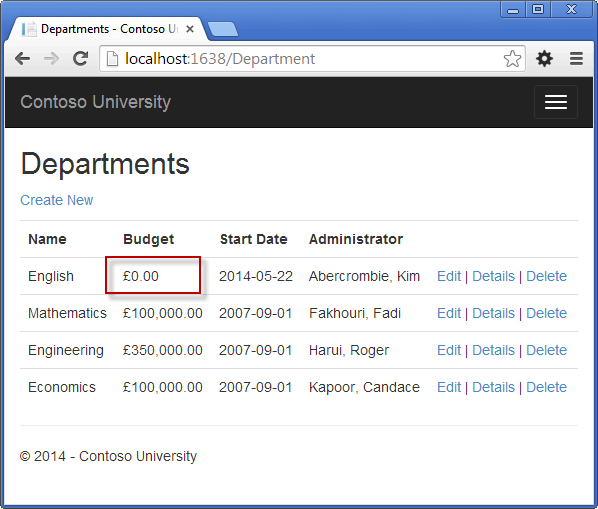
Change a field in the second browser tab and click Save.

Click Save in the second browser tab. You see an error message:
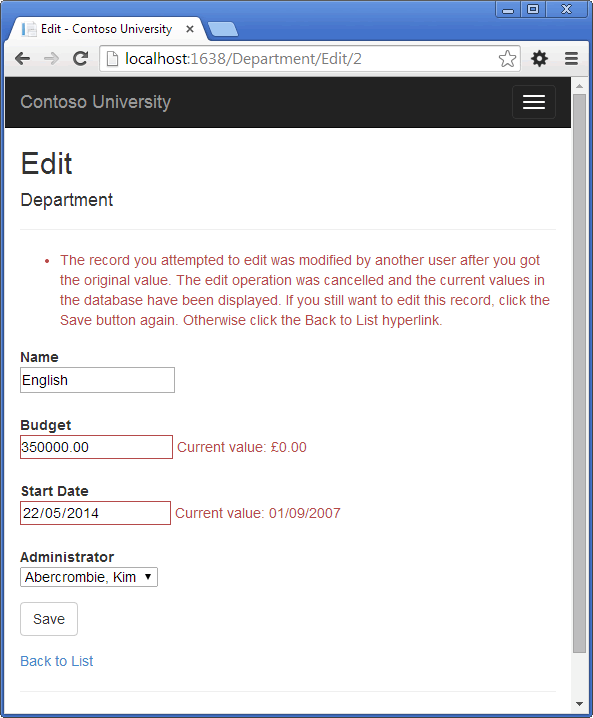
Click Save again. The value you entered in the second browser tab is saved along with the original value of the data you changed in the first browser. You see the saved values when the Index page appears.
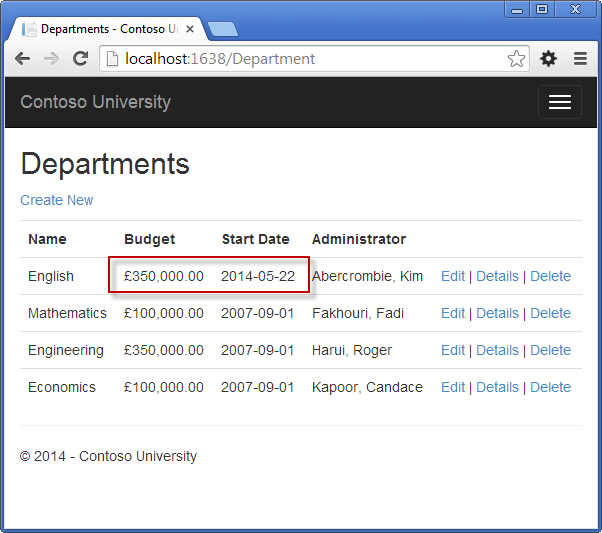
Updating the Delete Page
For the Delete page, the Entity Framework detects concurrency conflicts caused by someone else editing the department in a similar manner. When the HttpGet Delete method displays the confirmation view, the view includes the original RowVersion value in a hidden field. That value is then available to the HttpPost Delete method that's called when the user confirms the deletion. When the Entity Framework creates the SQL DELETE command, it includes a WHERE clause with the original RowVersion value. If the command results in zero rows affected (meaning the row was changed after the Delete confirmation page was displayed), a concurrency exception is thrown, and the HttpGet Delete method is called with an error flag set to true in order to redisplay the confirmation page with an error message. It's also possible that zero rows were affected because the row was deleted by another user, so in that case a different error message is displayed.
In DepartmentController.vb, replace the HttpGet Delete method with the following code:
Async Function Delete(ByVal id As Integer?, ByVal concurrencyError As Boolean?) As Task(Of ActionResult) If IsNothing(id) Then Return New HttpStatusCodeResult(HttpStatusCode.BadRequest) End If Dim department As Department = Await db.Departments.FindAsync(id) If IsNothing(department) Then If concurrencyError = True Then Return RedirectToAction("Index") End If Return HttpNotFound() End If If concurrencyError.GetValueOrDefault() Then If IsNothing(department) Then ViewBag.ConcurrencyErrorMessage = "The record you attempted to delete " & _ "was deleted by another user after you got the original values. " & _ "Click the Back to List hyperlink." Else ViewBag.ConcurrencyErrorMessage = "The record you attempted to delete " & _ "was modified by another user after you got the original values. " & _ "The delete operation was canceled and the current values in the " & _ "database have been displayed. If you still want to delete this " & _ "record, click the Delete button again. Otherwise " & _ "click the Back to List hyperlink." End If End If Return View(department) End Function
The method accepts an optional parameter that indicates whether the page is being redisplayed after a concurrency error. If this flag is true, an error message is sent to the view using a ViewBag property.
Replace the code in the HttpPost Delete method (named DeleteConfirmed) with the following code:
<HttpPost()> <ValidateAntiForgeryToken()> Async Function Delete(ByVal department As Department) As Task(Of ActionResult) Try db.Entry(department).State = EntityState.Deleted Await db.SaveChangesAsync() Return RedirectToAction("Index") Catch ex As DbUpdateConcurrencyException Return RedirectToAction("Delete", New With {.concurrencyError = True, .id = department.DepartmentID}) Catch dex As DataException 'Log the error ModelState.AddModelError(String.Empty, "Unable to delete. Try again, and if the problem persists contact your system administrator.") Return View(department) End Try End Function
In the scaffolded code that you just replaced, this method accepted only a record ID:
Async Function DeleteConfirmed(ByVal id As Integer) As Task(Of ActionResult)
You've changed this parameter to a Department entity instance created by the model binder. This gives you access to the RowVersion property value in addition to the record key.
Async Function Delete(ByVal department As Department) As Task(Of ActionResult)
You have also changed the action method name from DeleteConfirmed to Delete. The scaffolded code named the HttpPost Delete method DeleteConfirmed to give the HttpPost method a unique signature. ( The CLR requires overloaded methods to have different method parameters.) Now that the signatures are unique, you can stick with the MVC convention and use the same name for the HttpPost and HttpGet delete methods.
If a concurrency error is caught, the code redisplays the Delete confirmation page and provides a flag that indicates it should display a concurrency error message.
In Views\Department\Delete.vbhtml, replace the scaffolded code with the following code that adds an error message field and hidden fields for the DepartmentID and RowVersion properties. The changes are highlighted.
@ModelType ContosoUniversity.Models.Department @Code ViewBag.Title = "Delete" End Code <h2>Delete</h2> <p class="error">@ViewBag.ConcurrencyErrorMessage</p> <h3>Are you sure you want to delete this?</h3> <div> <h4>Department</h4> <hr /> <dl class="dl-horizontal"> <dt> Administrator </dt> <dd> @Html.DisplayFor(Function(model) model.Administrator.FullName) </dd> <dt> @Html.DisplayNameFor(Function(model) model.Name) </dt> <dd> @Html.DisplayFor(Function(model) model.Name) </dd> <dt> @Html.DisplayNameFor(Function(model) model.Budget) </dt> <dd> @Html.DisplayFor(Function(model) model.Budget) </dd> <dt> @Html.DisplayNameFor(Function(model) model.StartDate) </dt> <dd> @Html.DisplayFor(Function(model) model.StartDate) </dd> </dl> @Using (Html.BeginForm()) @Html.AntiForgeryToken() @Html.HiddenFor(Function(model) model.DepartmentID) @Html.HiddenFor(Function(model) model.RowVersion) @<div class="form-actions no-color"> <input type="submit" value="Delete" class="btn btn-default" /> | @Html.ActionLink("Back to List", "Index") </div> End Using </div>
This code adds an error message between the h2 and h3 headings:
<p class="error">@ViewBag.ConcurrencyErrorMessage</p>
It replaces LastName with FullName in the Administrator field:
<dt> Administrator </dt> <dd> @Html.DisplayFor(Function(model) model.Administrator.FullName) </dd>
Finally, it adds hidden fields for the DepartmentID and RowVersion properties after the Html.BeginForm statement:
@Html.HiddenFor(Function(model) model.DepartmentID) @Html.HiddenFor(Function(model) model.RowVersion)
Run the Departments Index page. Right click the Delete hyperlink for the English department and select Open in new tab, then in the first tab click the Edit hyperlink for the English department.
In the first window, change one of the values, and click Save :

The Index page confirms the change.

In the second tab, click Delete.
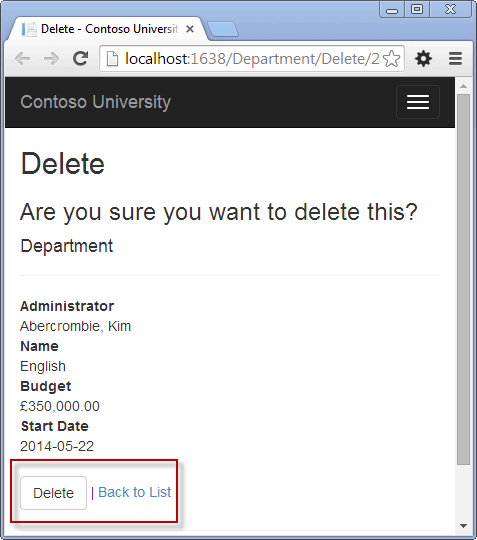
You see the concurrency error message, and the Department values are refreshed with what's currently in the database.
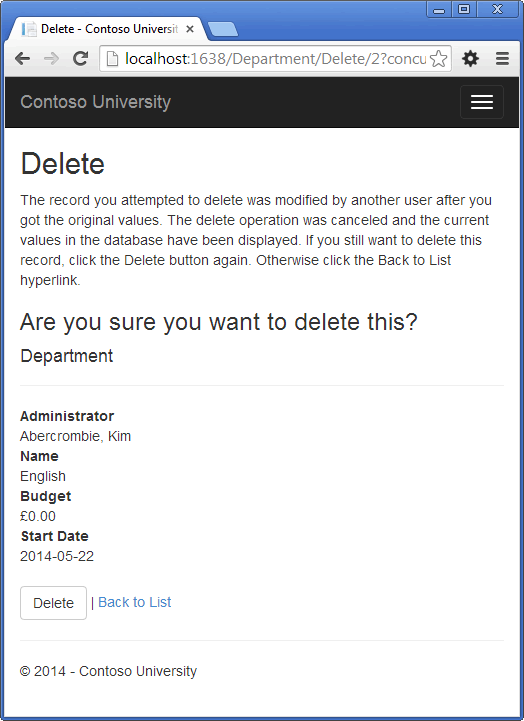
If you click Delete again, you're redirected to the Index page, which shows that the department has been deleted.
Summary
This completes the introduction to handling concurrency conflicts. For information about other ways to handle various concurrency scenarios, see Optimistic Concurrency Patterns and Working with Property Values on MSDN. The next tutorial shows how to implement table-per-hierarchy inheritance for the Instructor and Student entities.
